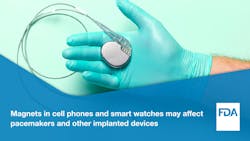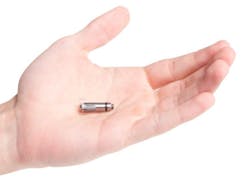At a Glance:
- Research confirms cell phones and smart watches should be kept at least 6 in. away from implanted medical devices such as pacemakers.
- Magnetic safe mode can be triggered accidentally from strong magnetic fields greater than 10G.
- There’s no need to steer clear of electric cars if you have a pacemaker.
Pacemakers come with an FDA warning: Avoid interference between cell phones and smart watches and your heart device.
The concern for pacemaker wearers has been whether electronic devices can interfere with their life-saving device. And for many years, pacemaker wearers have heeded the advice to keep cell phones at least 6 in. away from their implanted medical device. The same holds true for large motors, such as cars or boats.
Now, investigators affiliated with the Center for Devices and Radiological Health (CDRH) at the US Food and Drug Administration have concluded a study that supports the FDA recommendation. The findings, reported in Heart Rhythm, validate that consumer electronic devices may create magnetic interference. Cell phones and smart watches, the research confirmed, should be kept at least 6 in. away from implanted medical devices, in particular pacemakers and cardiac defibrillators.
“As part of this work, the agency reviewed recently published articles describing the possibility that certain newer cell phones, smart watches and other consumer electronics with high field strength magnets may temporarily affect the normal operation of implanted electronic medical devices, such as pacemakers and implantable defibrillators,” explained lead investigator Seth J. Seidman, a Research electrical engineer and EMC program advisor with the CDRH. The review prompted further testing to confirm and help inform appropriate recommendations.
Most pacemakers respond to magnets by switching to an asynchronous pacing mode. Strong magnetic fields from consumer electronic devices and motors may create a magnetic field that can activate the pacemaker’s “magnetic mode” when in close contact. Magnetic safe mode, however, is designed to be used when a patient is undergoing a procedure where electromagnetic interference is possible, or when it is necessary to suspend the pacemaker during a medical treatment.
The CDRH researchers cautioned that this feature can be triggered accidentally from strong magnetic fields greater than 10G, which can change how the device works and could result in serious harm to the patient. The development of technologies and the use of new materials such as small rare-earth magnets—found in headphones, door locks or small phone speakers—can emit strong magnetic fields.
The investigators tested the magnetic field output of iPhone 12 and Apple Watch 6 models at varying distances from the devices. All the devices have static magnetic fields significantly greater than 10G in close proximity, which would be high enough to trigger magnetic mode in implanted cardiac devices. However, they reported that this is averted when the aforementioned separation distance of 6 in. or more is maintained.
The CDRH researchers stated that the risk to patients remains low. Still, Seidman cautioned that the number of consumer electronics with strong magnets is expected to increase over time. The recommendation, he said, is that “people with implanted medical devices talk with their healthcare providers to ensure they understand this potential risk and the proper techniques for safe use.”
Proactive and Preventive Measures
Similarly, a recent study published in Technology and Health Care offered some reassurance for pacemaker wearers and physician concerns regarding the use of electric cars. The study reported that four leading brands of commercially available e-cars (Nissan LEAF, Tesla Model S P85, BMW i3, and VW eUp) used in the test did not trigger electromagnetic interference (EMI) with cardiac implantable electronic devices (CIED).
According to the e-car study findings, neither adverse events nor EMI were detected when 108 CIED patients drove and charged the e-cars. Since these cars are equipped with shielding to prevent on-board systems against EMI, it likely explains the low magnetic field strength inside the cars, the researchers explained. The strongest electromagnetic field levels were detected during the charging of the vehicles, they noted.
The researchers stated that while the results are encouraging, rare events may still occur, and since technologies used are rapidly changing, it pays to exercise caution.
How do Pacemakers Work?
Pacemakers have come a long way since engineers tinkered with the first prototypes in the 1950s. For example, one of the first pacemaker prototypes resembled a small radio and measured about 12 in. in length. Contrast this to today’s smallest pacemaker, the Micra AV, which is comparable in size to a large vitamin capsule and less than one-tenth the size of traditional pacemakers.
Pacemakers stimulate the heart with electrical impulses so it beats at a normal rate and pumps more effectively. The type of pacemaker selected for a patient depends on the symptoms and condition of the recipient. There are four basic types of pacemakers: single chamber, dual chamber, biventricular and leadless.
Pacemakers are made up of two parts:
- A pulse generator (including a small lithium battery and a microprocessor with circuitry housed in a casing) that is typically implanted into the soft tissue beneath the skin in the chest. It functions to control the rate of pulses sent to the heart.
- Insulated wires (leads or electrodes), which are placed in one or more chambers of the heart to deliver electrical pulses to the heart. Newer pacemakers don’t have leads; they are implanted directly into the heart muscle.
Once the pacemaker is implanted in the chest, the pulse generator emits evenly timed electrical impulses (ultrasonic pulses) that create vibrations through the lead and turns into a current to stimulate the heart. The microprocessor records the heart’s electric activity and rhythm. In other words, pacemakers can sense when a patient’s heart rate missed a beat, or if it beats too slowly, and respond by sending signals at a steady rate.
They can be programmed to work on demand or according to your body’s needs. Their sensors may also recognize body movement or breathing rate, which allows them to speed up the discharge rate when you’re active.



